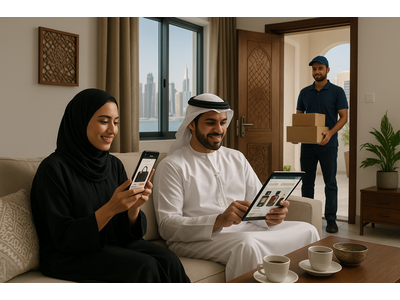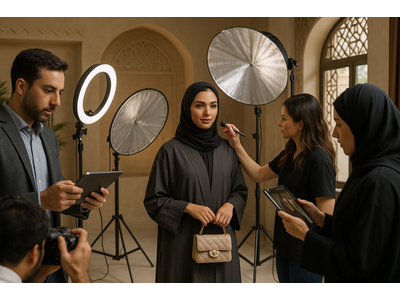The Middle East represents one of the most dynamic and rapidly evolving digital markets in the world. With high smartphone penetration rates, a young tech-savvy population, and significant government investments in digital infrastructure, the region offers tremendous opportunities for businesses looking to expand their digital presence. However, success in this market requires a nuanced understanding of local cultural sensitivities, consumer behaviors, and platform preferences.
At Aries Star Marketing OPC, our team has extensive experience developing and implementing digital marketing strategies tailored specifically for Middle Eastern audiences. In this article, we'll share key insights and best practices for effectively reaching and engaging consumers across the UAE, Saudi Arabia, Qatar, and other Gulf nations.
Understanding the Middle Eastern Digital Landscape
The Middle East boasts some of the highest social media usage rates globally, with countries like the UAE and Saudi Arabia leading the way. According to recent statistics:
- The UAE has a social media penetration rate of over 99%, one of the highest in the world
- Saudi Arabia has more than 25 million active social media users, representing 72% of the population
- Mobile internet usage in the region exceeds global averages, with many users accessing the internet exclusively via smartphones
- E-commerce growth has accelerated dramatically, with a 35% year-over-year increase in online shopping

Source: Digital 2024 Global Digital Overview
This digital-first environment creates abundant opportunities for brands, but also means that competition for attention is fierce. Standing out requires both technical expertise and cultural intelligence.
Cultural Considerations for Middle Eastern Marketing
Perhaps the most critical factor in successful Middle Eastern marketing is cultural sensitivity. The region's rich cultural heritage and religious traditions significantly influence consumer behavior and expectations.
Key Cultural Factors to Consider:
- Religious Observances: Marketing campaigns should respect and acknowledge important religious periods like Ramadan and Eid. During Ramadan, consumption patterns change dramatically, with increased online activity during nighttime hours.
- Language Nuances: While English is widely understood in business contexts, Arabic content resonates more deeply with local audiences. However, Arabic dialects vary significantly across the region, so localization should be specific to target markets.
- Visual Sensitivities: Imagery should respect local modesty standards and cultural norms. This includes appropriate dress in advertisements and avoiding imagery that conflicts with local values.
- Family-Centric Messaging: Family plays a central role in Middle Eastern societies. Marketing that acknowledges family values often performs better than individualistic messaging common in Western markets.

Ramadan-themed marketing campaign by a major retailer in Dubai
"Understanding the cultural context isn't just about avoiding mistakes—it's about creating authentic connections. When brands demonstrate genuine cultural awareness, Middle Eastern consumers respond with remarkable loyalty." — Fatima Al-Hashimi, Digital Marketing Director, Aries Star Marketing OPC
Platform Strategy: Where to Focus Your Efforts
While global platforms like Facebook, Instagram, and YouTube maintain strong presences in the Middle East, platform preferences and usage patterns differ from Western markets in important ways.
Top Platforms by Engagement:
- Instagram: Particularly popular among younger demographics and luxury consumers. The UAE has one of the highest Instagram engagement rates globally.
- YouTube: Extremely popular across all age groups, with Arabic content consumption growing rapidly. Saudi Arabia ranks among the top countries worldwide for YouTube consumption per capita.
- Snapchat: Enjoys exceptional popularity in Saudi Arabia and the UAE, with higher usage rates than many Western countries.
- TikTok: Growing explosively, particularly among users under 30.
- WhatsApp: Beyond personal communication, WhatsApp is increasingly important for business communication and customer service.
- LinkedIn: Dominant for B2B marketing, especially in the UAE and Qatar.
- Twitter: Significant for news consumption and public discourse, particularly in Saudi Arabia.

Relative popularity of social platforms across key Middle Eastern markets
Regional platforms also deserve attention. For example, Anghami (a music streaming service) offers unique advertising opportunities for reaching local audiences.
Content Strategy: What Resonates with Middle Eastern Audiences
Content that performs well in the Middle East often shares certain characteristics that align with regional preferences and values:
High-Performing Content Types:
- Video Content: Video consumption rates in the region are among the highest globally. Short-form video is particularly effective for reaching younger audiences.
- Storytelling: Content that tells a compelling story, especially one that reflects local traditions or family values, typically outperforms purely promotional material.
- Localized Visuals: Imagery featuring local landmarks, cultural references, and people who reflect the diversity of the region creates stronger connections.
- Bilingual Approach: Content that thoughtfully incorporates both Arabic and English often reaches broader audiences while demonstrating cultural respect.
- Influencer Collaborations: The influence economy is particularly strong in the Gulf region, with local influencers commanding significant trust and engagement.

Example of successful localized content campaign for a global brand
Paid Media Strategy: Optimizing for ROI
Paid advertising in the Middle East requires specific approaches to maximize return on investment:
Key Considerations for Paid Campaigns:
- Higher CPCs: Cost-per-click tends to be higher in Gulf markets compared to global averages, particularly in competitive sectors like luxury goods, real estate, and finance.
- Timing Sensitivity: Ad performance varies significantly during religious observances. For example, ad costs typically increase during Ramadan, while engagement patterns shift to nighttime hours.
- Mobile Optimization: With mobile-first users dominating the market, campaigns must be designed with mobile experience as the priority.
- Geo-Targeting Precision: The region's concentrated urban populations make precise geo-targeting particularly effective, especially in city-states like Dubai and Doha.
- Language Targeting: Campaigns should leverage platform capabilities to target users based on language preferences, with separate strategies for Arabic and English content.

Performance comparison of Arabic vs. English ad campaigns in UAE market
Case Study: Luxury Retailer's Middle East Expansion
One of our clients, a European luxury retailer, sought to expand their digital presence across the UAE, Saudi Arabia, and Qatar. Their initial approach—simply translating their European campaigns into Arabic—yielded disappointing results despite significant ad spend.
Our team developed a comprehensive strategy that included:
- Creating market-specific content that reflected local luxury consumption patterns
- Developing partnerships with carefully selected regional influencers
- Implementing a sophisticated paid media strategy with dayparting optimized for local browsing habits
- Building a WhatsApp-based VIP customer service program for high-value clients
The results were transformative:
- 300% increase in engagement rates
- 42% reduction in customer acquisition costs
- 156% growth in online sales within 6 months
- Establishment of a loyal customer base that now drives significant word-of-mouth referrals

Visual representation of campaign performance metrics
Practical Recommendations for Businesses
Based on our experience helping companies succeed in Middle Eastern markets, we recommend the following approach:
1. Invest in Cultural Intelligence
Work with partners who truly understand the nuances of the region. This goes beyond translation to include cultural context, local consumer psychology, and regional business practices.
2. Develop Market-Specific Strategies
Avoid treating "the Middle East" as a monolithic market. Saudi Arabia, the UAE, Qatar, and other countries have distinct digital ecosystems and consumer preferences that require tailored approaches.
3. Prioritize Mobile Experience
With some of the highest smartphone penetration rates globally, your entire digital presence—from ads to websites to checkout processes—must be optimized for mobile users.
4. Balance Global Brand with Local Relevance
The most successful international brands in the region maintain their core identity while thoughtfully adapting to local expectations and preferences.
5. Plan Around Cultural Calendar
Develop a marketing calendar that accounts for important religious and cultural observances, with specific strategies for high-impact periods like Ramadan.

Strategic planning framework for Middle Eastern markets
Conclusion: The Opportunity Ahead
The Middle Eastern digital market continues to evolve at a remarkable pace, driven by young, tech-savvy consumers, significant infrastructure investments, and government initiatives promoting digital transformation. For businesses that approach the region with cultural intelligence and technical expertise, the opportunities are substantial.
At Aries Star Marketing OPC, our team combines global marketing best practices with deep regional expertise to help businesses navigate this complex but rewarding landscape. Our presence in the UAE, coupled with our international perspective, positions us uniquely to bridge the gap between global brands and Middle Eastern consumers.
Whether you're just beginning to explore opportunities in the region or looking to optimize your existing Middle Eastern digital strategy, we invite you to connect with our team to discuss how we can support your growth objectives.









Mohammed S.
March 16, 2024This article perfectly captures the nuances of marketing in the Middle East. As a marketing manager for a retail chain in Dubai, I've seen firsthand how important cultural sensitivity is. The Ramadan timing strategies mentioned have been particularly effective for our campaigns.
Sarah L.
March 17, 2024I appreciate the detailed breakdown of platform preferences. We've been focusing heavily on Facebook for our campaigns in Saudi Arabia, but based on this article, we should probably shift more resources to Snapchat and Instagram. Thank you for the insights!
Khalid A.
March 18, 2024The case study about the luxury retailer was particularly interesting. We're facing similar challenges with our European brand entering the UAE market. Would love to hear more about how you handled the influencer selection process, as finding the right partners has been challenging for us.